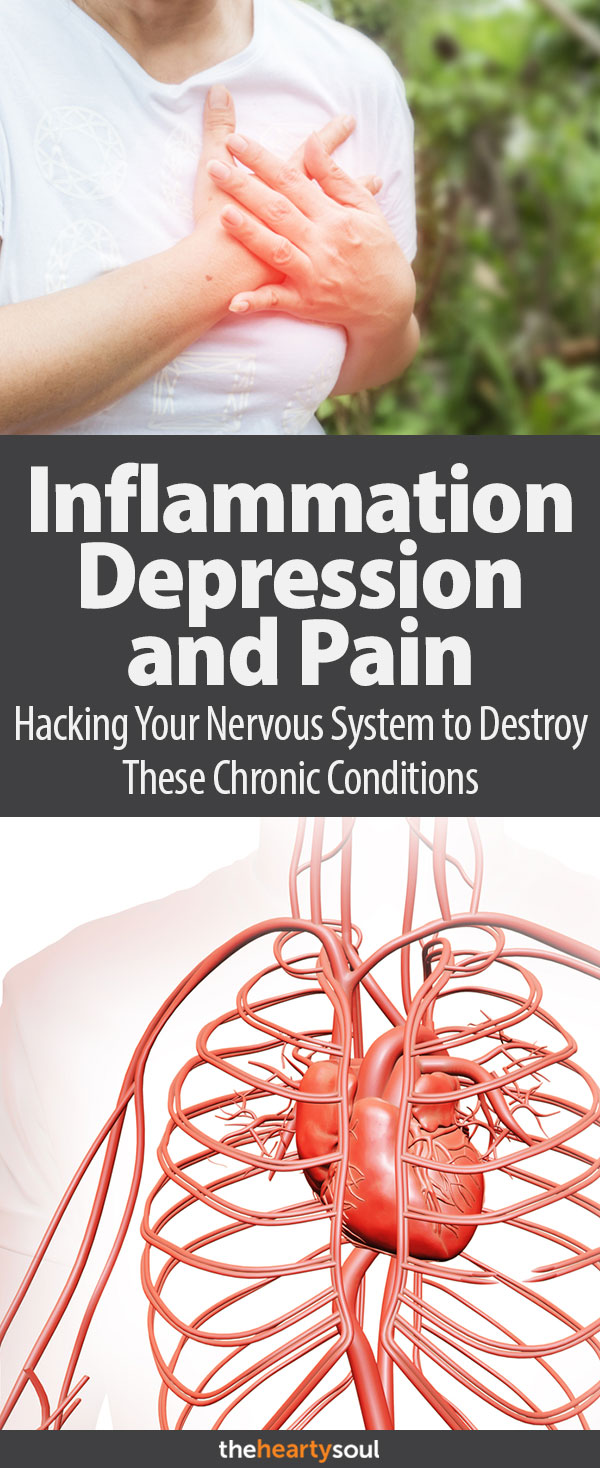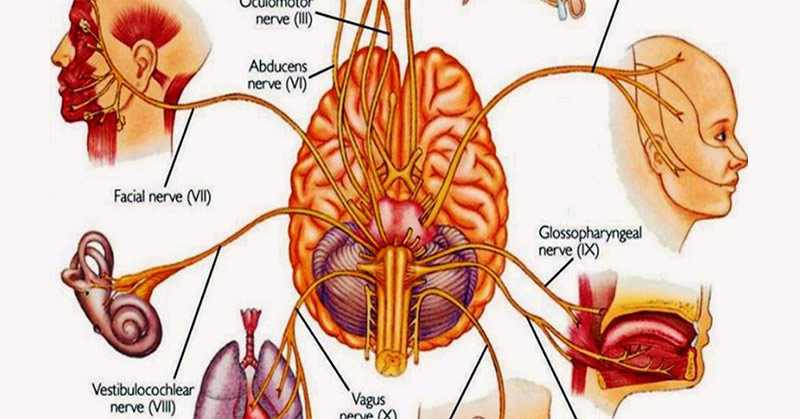The vagus nerve is something that is becoming more appreciated all the time as scientists continue to research it. This nerve could be an answer to reducing chronic inflammation in the body. While some research has focused on stimulating it through implants, there are actually less invasive and more natural ways to stimulate the vagus nerve.
What is the Vagus Nerve?
The vagus nerve is part of the parasympathetic nervous system that controls our “fight or flight” adrenaline response to stress and danger. However, some people’s vagus nerve is stronger than others, which allows their bodies to relax more quickly after an adrenaline rush. The strength of the nerve response is called the vagal tone, and it could be measured by a person’s heart rate.
The vagus nerve has both sensory and motor functions, including:
- providing sensations for the skin behind the ear, the outer part of the ear canal, and some parts of the throat, as well as the lungs, trachea, heart, and most of the digestive tract
- stimulating muscles in the heart, pharyx, larynx, and soft palate, and stimulating contractions in the digestive tract [1]
The Evidence for Vagal Nerve Stimulation
In 2011, a pilot study fitted electrical implants directly on the vagus nerves of 20 volunteers with rheumatoid arthritis (RA). The aim was to ‘switch off’ the immune system in cases where it attacks the body rather than alien cells, or in chronic conditions, like RA.
Vagal nerve stimulation has already been approved for people with epilepsy, so preliminary evidence was already there for other conditions. Once the pacemaker was inserted into the throat, volunteers were given magnets to swipe across the area six times a day. This stimulated the nerve for 30 seconds each time. More than half of the patients had significant improvement and a third went into remission. Sixteen of the twenty felt better as inflammation in their blood also lowered. Some are drug-free now. None of the patients wanted the implant removed.
Later, in a 2016 study further support was garnered for the idea that vagal nerve stimulation can help regulate inflammation and reduce the symptoms of RA.
According to Kevin J. Tracey, president, and CEO of the Feinstein Institute for Medical Research,
“This is a real breakthrough in our ability to help people suffering from inflammatory diseases. While we’ve previously studied animal models of inflammation until now we had no proof that electrical stimulation of the vagus nerve can indeed inhibit cytokine production and reduce disease severity in humans. I believe this study will change the way we see modern medicine, helping us understand that our nerves can, with a little help, make the drugs that we need to help our body heal itself.” [3]
Read: 15 Symptoms of Low Dopamine and Top Herbs to Increase Dopamine Levels
Can The Nerve Be Stimulated Naturally?
The good news is, you don’t need an implant to raise your vagal tone. A 2010 study with 65 participants showed positive emotions can contribute to one’s health and vagal tone.
“That was the first experimental evidence that if you increased positive emotions and that led to increased social closeness, then vagal tone changed,” says Bethany Kok, a researcher for the trial [2].
Good Vs. Poor Vagal Tone
| Good vagal tone is associated with [4]: | Poor vagal tone is associated with [3]: |
| positive emotions | chronic inflammation |
| good physical health | depression |
| positive social connections | negative moods |
| loneliness | |
| heart attacks | |
| stroke |
Vagus nerve stimulation is also used to treat some cases of depression that do not respond to standard treatment, and researchers believe it could be used in the future to treat Alzheimer’s disease, multiple sclerosis, and cluster headaches. [1] While the majority of the studied benefit seems to come from implantable vagus nerve-stimulating devices, the underlying theory remains the same: stimulate your vagus nerve, improve vagal tone, and support your health. So here are some ways to do that.

6 Natural Ways to Increase Vagal Tone and Stimulate the Vagus Nerve
- Deep breathing – Deep, diaphragmatic breaths to slow respiration can stimulate the vagus nerve. Try breathing six times per minute, inhaling for five seconds, and exhaling for five seconds. [5]
- Humming – A study done by the International Journal of Yoga found that chanting ‘OM’ was more effective at stimulating the nerve than by simply resting. Chanting ‘OM’ or humming creates a vibrating sensation around the ears that is believed to transmit to the vagus nerve. [6]
- Yoga – Although yoga poses have their own benefits, a yoga practice like Kripalu with a specific focus on relaxation and breath is particularly helpful. If you practice or are interested in another form of yoga, bring directed, conscious breathing into your sessions. [7]
- Meditation – Meditation is a tool anyone can use at any time, whether it’s for only a few minutes or for a longer period of time. The simple act of taking a few deep breaths to calm down is a form of meditation. Make it a part of your routine but setting a time where you can relax and focus on your breath. Notice what other sensations you feel in your body. You can also add some chanting or humming to your practice for added stimulation. Meditation is a great time to manifest positives thoughts and to practice the deep breathing techniques as mentioned above.
- Coldwater face immersion post-exercise – Exercise increases heart rate but washing your face with cold water immediately after has been found to be effective in accelerating the reactivation of the vagus nerve to reduce heart rate and increase the movement of the digestive system [8]. This works best with dipping most of the face into a basin of cold water as opposed to total submersion.
- Increased salivation – Salvia production induced by the vagus nerve activation, so when you salivate, you know it’s is at work. This is most effective in a calm state. To induce salivation and therefore vagus nerve stimulation, try sitting in a reclining position and imaging a salivatory food like lemon. Breathe deeply, relax the body, and try to maintain this feeling for as long as it is comfortable [9]. If you’re salivating, you know its working.

Although science has made large strides with regards to the benefit of stimulating the vagus nerve, more research is needed. Lastly, more research is also needed to validate some of the less invasive and more natural ways of achieving safe vagal stimulation. Until then, deep breathing has been shown to be the most effective stimulant for the nerve, so find a way to bring conscious breath into your routine whether it’s through setting aside a few minutes a day, or signing up for yoga classes or meditation sessions.
Sources:
- “Vagus Nerve Overview.” Jill Seladi-Schulman, PhD. Healthline. August 27, 2018
- “Hacking the nervous system.” Gaia Vince. Mosaic. May 25, 2015
- “Vagus Nerve Stimulation Dramatically Reduces Inflammation.” Christopher Bergland. Psychology Today. July 6, 2016
- “How Positive Emotions Build Physical Health: Perceived Positive Social Connections Account for the Upward Spiral Between Positive Emotions and Vagal Tone.” Behtany E. Kok, Kimberly Al. Coffey, Michael A. Cohn. Sage Journals. May 6, 2013
- “I Now Suspect the Vagus Nerve Is the Key to Well-being.” Edith Zimmerman. The Cut. May 9, 2019
- “Neurohemodynamic correlates of ‘OM’ chanting: A pilot functional magnetic resonance imaging study.” Bangalore G Kalyani, Ganesan Venkatasubramanian, Rashmi Arasappa, Naren P Rao, Sunil V Kalmady, Rishikesh V Behere, Hariprasad Rao, Mandapati K Vasudev, and Bangalore N Gangadhar. International Journal of Yoga. June 2011
- “Breath of Life: The Respiratory Vagal Stimulation Model of Contemplative Activity.” Frontiers in Human Neuroscience. Roderik J. S. Gerritsen, and Guido P. H. Band. October 9, 2018.
- “Influence of Cold Water Face Immersion on Post-Exercise Parasympathetic Reactivation” https://pubmed.ncbi.nlm.nih.gov/19882167/

